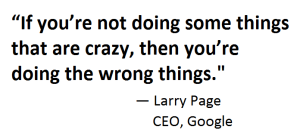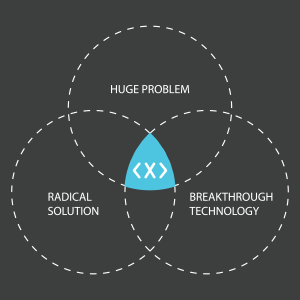Most individuals and companies would be perfectly happy increasing productivity or improving their product by 10 percent. Progress is progress, right?
 That’s not the case for Larry Page, CEO for Google. Instead, he challenges his company and the world to think in moonshots — ideas so large, that they require the kind of creativity and innovation that are necessary to literally and figuratively put a man on the moon. This way of thinking tasks us all to do things “times 10,” rather than settling for marginal increases. His philosophy on moonshot thinking and its role at Google provides a great lesson for us all.
That’s not the case for Larry Page, CEO for Google. Instead, he challenges his company and the world to think in moonshots — ideas so large, that they require the kind of creativity and innovation that are necessary to literally and figuratively put a man on the moon. This way of thinking tasks us all to do things “times 10,” rather than settling for marginal increases. His philosophy on moonshot thinking and its role at Google provides a great lesson for us all.

“If you’re not doing some things that are crazy, then you’re doing the wrong things,” says Page about why moonshots matter.
The head of Google[x], Astro Teller, says that aiming for a goal “times 10” is actually easier than improving something by just 10 percent. That’s because, he says, marginally improving what exists makes it easy to focus on what is already present. That type of thinking inevitably causes us to rely on existing tools and assumptions. However, when we free ourselves up to think in moonshots, we rely more on creativity, collaboration and innovation.Google has a dedicated branch responsible for building moonshot ideas, known as Google[x]. It’s the division that initiated Google Glass and works on other hundreds of projects such as a self-driving car. It champions radical thinking across all disciplines. The group’s forum, Solve for X, encourages everyone to think radically, collaborate and work to solve global problems.
WHY MOONSHOT THINKING MATTERS TO MARKETERS
Moonshot thinking can be applied across industry and profession. At Google, the primary focus is innovation in technology and how to make search more relevant in our lives. It aims to help connect us all to the world and to the information we need. But for each individual, moonshot thinking can be applied in a way that helps elevate us to the next level — whether that is a project, business or new idea.
Marketers, in particular, can apply moonshot thinking to their work. For digital marketers, in particular, thinking in moonshots can be particularly beneficial. As a space that is constantly evolving, those that are willing to think big in the digital world are more likely to succeed.
Burn Out versus Creativity
Marketers are required to be the optimal blend of creative and analytical. They represent a constant balance between the right and left brain. They take great pride in trying something new with the reward of knowing that it can be tested, measured and repeated. Thinking in moonshots doesn’t necessarily mean abandoning the analytical side. It just dares us all to think beyond immediate metrics and traditional practices. When thinking in moonshots, the unexpected brings innovation for strategies and concepts that no one has thought of before.
Moonshots allow marketers to free themselves. The mentality of taking a chance and trying new things allows creative juices to flow — both yielding exciting results and also reducing the burnout that comes from constantly towing the line between creativity and providing immediate, tangible results.
Risk for the Sake of Reward
In digital marketing, this proverbial balance between creativity and showing results sometimes gives way to the analytical left brain. As marketers compete for budget allocations and resources, the burden of proof sometimes overtakes the creative drive. By freeing up yourself and your team to occasionally take risks, without the burden of proof, you get results that are sometimes unimaginably successful.
Motivation Rather than Stagnation
Many are not willing to sacrifice precious time and resources for something that only has the chance of succeeding. But for companies that thrive on innovation like Google, it is essential. Providing even occasional opportunities for moonshot thinking on a team can help a company innovate, drive results, prevent burnout and maintain top talent.
When you inspire yourself and those around you to think in moonshots, you inspire and motivate your team. By definition, moonshot thinking requires teamwork, collaboration, creativity and innovation. Rather than stagnation, teams are inspired to build and grow.
Conclusion
Making moonshot thinking part of your digital strategy takes risk and flexibility. However, the correct blend of moonshots in a strategy can help continue to propel your brand and company forward. Taking risks can yield incredible rewards. Companies like Google have seen the reward of allowing their team members to think boldly because they know that the future cannot be predicted. They know that the best ideas often come when individuals and teams are allowed to forgo the status quo and think big.
